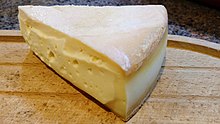Stinking Bishop cheese
| Stinking Bishop | |
|---|---|
 |
|
| Country of origin | United Kingdom |
| Region | Gloucestershire |
| Town | Dymock |
| Source of milk | Cow |
| Pasteurised | Yes |
| Texture | Smooth, creamy, semi-soft |
| Fat content | 48% |
| Aging time | c. 4 months |
| Certification | - |
Stinking Bishop is an award-winning, washed-rind cheese produced since 1994 by Charles Martell and Son at Hunts Court Farm, Dymock, Gloucestershire, in the south west of England. It is made from the milk of Gloucester cattle, which originally consisted of only 68 Gloucester breed heifers. Charles Martell helped revive the cow to make production of the cheese possible, though it is often combined and pasteurised with the milk of Friesian cattle from a nearby county. The fat content is 48%.
The colour ranges from white/yellow to beige, with an orange to grey rind. It is moulded into wheels 2 kg (4.4 lb) in weight, 20 cm (8 inch) in diameter, and 4 cm (1.5 inch) deep. Only about 20 tonnes are produced each year.
The distinctive odour comes from the process with which the cheese is washed during its ripening; it is immersed in perry made from the local Stinking Bishop pear (from which the cheese gets its name) every four weeks while it matures. This process makes it a monastic type of cheese which owes its origin to the Cistercian monks who once farmed the pastures of Hunts Court Farm whence it was launched in 1994. As with many monastic cheeses, this variety is matured in humid cave-like conditions. To increase the moisture content and to encourage bacterial activity, salt is not added until the cheese is removed from its mould.
In 2017, Stinking Bishop launched a bid to become the Easter cheese. Including a full-scale social media campaign, in-store media for their UK-wide stockists and a competition to win a tour around Hunts Court Farm.
Stinking Bishop is an artisanal, handmade cheese and is therefore not produced for supermarkets. It currently has over 130 stockists across the UK, and can be found in artisan food stores and delicatessens, as well as in Harrods and Selfridges.
The cheese was brought to international attention in the 2005 animated film Wallace & Gromit: The Curse of the Were-Rabbit, in which it was used to revive Wallace from the dead. Demand for the cheese subsequently rose by 500%, forcing the cheesemaker to hire more people and increase production.
...
Wikipedia
